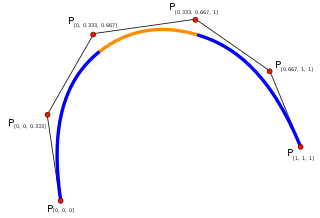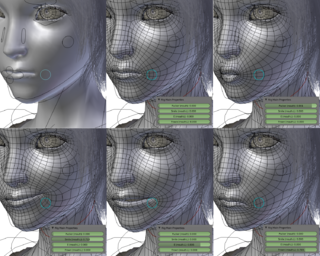
Computer animation is the process used for digitally generating animated images. The more general term computer-generated imagery (CGI) encompasses both static scenes and dynamic images, while computer animation only refers to moving images. Modern computer animation usually uses 3D computer graphics to generate a two-dimensional picture, although 2D computer graphics are still used for stylistic, low bandwidth, and faster real-time renderings. Sometimes, the target of the animation is the computer itself, but sometimes film as well.

In the mathematical field of numerical analysis, interpolation is a type of estimation, a method of constructing new data points within the range of a discrete set of known data points.
A key frame in animation and filmmaking is a drawing or shot that defines the starting and ending points of any smooth transition. These are called frames because their position in time is measured in frames on a strip of film or on a digital video editing timeline. A sequence of key frames defines which movement the viewer will see, whereas the position of the key frames on the film, video, or animation defines the timing of the movement. Because only two or three key frames over the span of a second do not create the illusion of movement, the remaining frames are filled with "inbetweens".

In the mathematical subfield of numerical analysis, a B-spline or basis spline is a spline function that has minimal support with respect to a given degree, smoothness, and domain partition. Any spline function of given degree can be expressed as a linear combination of B-splines of that degree. Cardinal B-splines have knots that are equidistant from each other. B-splines can be used for curve-fitting and numerical differentiation of experimental data.

Motion compensation is an algorithmic technique used to predict a frame in a video, given the previous and/or future frames by accounting for motion of the camera and/or objects in the video. It is employed in the encoding of video data for video compression, for example in the generation of MPEG-2 files. Motion compensation describes a picture in terms of the transformation of a reference picture to the current picture. The reference picture may be previous in time or even from the future. When images can be accurately synthesized from previously transmitted/stored images, the compression efficiency can be improved.
Inbetweening or tweening is a key process in all types of animation, including computer animation. It is the process of generating intermediate frames between two images, called key frames, to give the appearance that the first image evolves smoothly into the second image. Inbetweens are the drawings which create the illusion of motion.

Shading refers to the depiction of depth perception in 3D models or illustrations by varying the level of darkness. Shading tries to approximate local behavior of light on the object's surface and is not to be confused with techniques of adding shadows, such as shadow mapping or shadow volumes, which fall under global behavior of light.

Non-uniform rational basis spline (NURBS) is a mathematical model using basis splines (B-splines) that is commonly used in computer graphics for representing curves and surfaces. It offers great flexibility and precision for handling both analytic and modeled shapes. It is a type of curve modeling, as opposed to polygonal modeling or digital sculpting. NURBS curves are commonly used in computer-aided design (CAD), manufacturing (CAM), and engineering (CAE). They are part of numerous industry-wide standards, such as IGES, STEP, ACIS, and PHIGS. Tools for creating and editing NURBS surfaces are found in various 3D graphics and animation software packages.

In mathematics, a spline is a special function defined piecewise by polynomials. In interpolating problems, spline interpolation is often preferred to polynomial interpolation because it yields similar results, even when using low degree polynomials, while avoiding Runge's phenomenon for higher degrees.
In numerical analysis, a cubic Hermite spline or cubic Hermite interpolator is a spline where each piece is a third-degree polynomial specified in Hermite form, that is, by its values and first derivatives at the end points of the corresponding domain interval.
In the field of 3D computer graphics, a subdivision surface is a curved surface represented by the specification of a coarser polygonal mesh and produced by a recursive algorithmic method. The curved surface, the underlying inner mesh, can be calculated from the coarse mesh, known as the control cage or outer mesh, as the functional limit of an iterative process of subdividing each polygonal face into smaller faces that better approximate the final underlying curved surface. Less commonly, a simple algorithm is used to add geometry to a mesh by subdividing the faces into smaller ones without changing the overall shape or volume.
Rotoshop is a proprietary graphics editing program created by Bob Sabiston.

In animation, a walk cycle is a series of frames or illustrations drawn in sequence that loop to create an animation of a walking character. The walk cycle is looped over and over, thus having to avoid animating each step again.
Temporal anti-aliasing (TAA) seeks to reduce or remove the effects of temporal aliasing. Temporal aliasing is caused by the sampling rate of a scene being too low compared to the transformation speed of objects inside of the scene; this causes objects to appear to jump or appear at a location instead of giving the impression of smoothly moving towards them. To avoid aliasing artifacts altogether, the sampling rate of a scene must be at least twice as high as the fastest moving object. The shutter behavior of the sampling system strongly influences aliasing, as the overall shape of the exposure over time determines the band-limiting of the system before sampling, an important factor in aliasing. A temporal anti-aliasing filter can be applied to a camera to achieve better band-limiting. A common example of temporal aliasing in film is the appearance of vehicle wheels travelling backwards, the so-called wagon-wheel effect. Temporal anti-aliasing can also help to reduce jaggies, making images appear softer.
Television standards conversion is the process of changing a television transmission or recording from one television system to another. The most common is from NTSC to PAL or the other way around. This is done so television programs in one nation may be viewed in a nation with a different standard. The video is fed through a video standards converter, which makes a copy in a different video system.

Motion interpolation or motion-compensated frame interpolation (MCFI) is a form of video processing in which intermediate animation frames are generated between existing ones by means of interpolation, in an attempt to make animation more fluid, to compensate for display motion blur, and for fake slow motion effects.
In kinematics, the motion of a rigid body is defined as a continuous set of displacements. One-parameter motions can be defined as a continuous displacement of moving object with respect to a fixed frame in Euclidean three-space (E3), where the displacement depends on one parameter, mostly identified as time.

Morph target animation, per-vertex animation, shape interpolation, shape keys, or blend shapes is a method of 3D computer animation used together with techniques such as skeletal animation. In a morph target animation, a "deformed" version of a mesh is stored as a series of vertex positions. In each key frame of an animation, the vertices are then interpolated between these stored positions.
Animation departments are the teams within a film studio that work on various aspects of animation such as storyboarding or 3D modeling. It can refer to a single department that handles animation as a whole or to multiple departments that handle specific tasks. It can also refer to a college department.
Motion interpolation is a programming technique in data-driven character animation that creates transitions between example motions and to extrapolates new motions.









